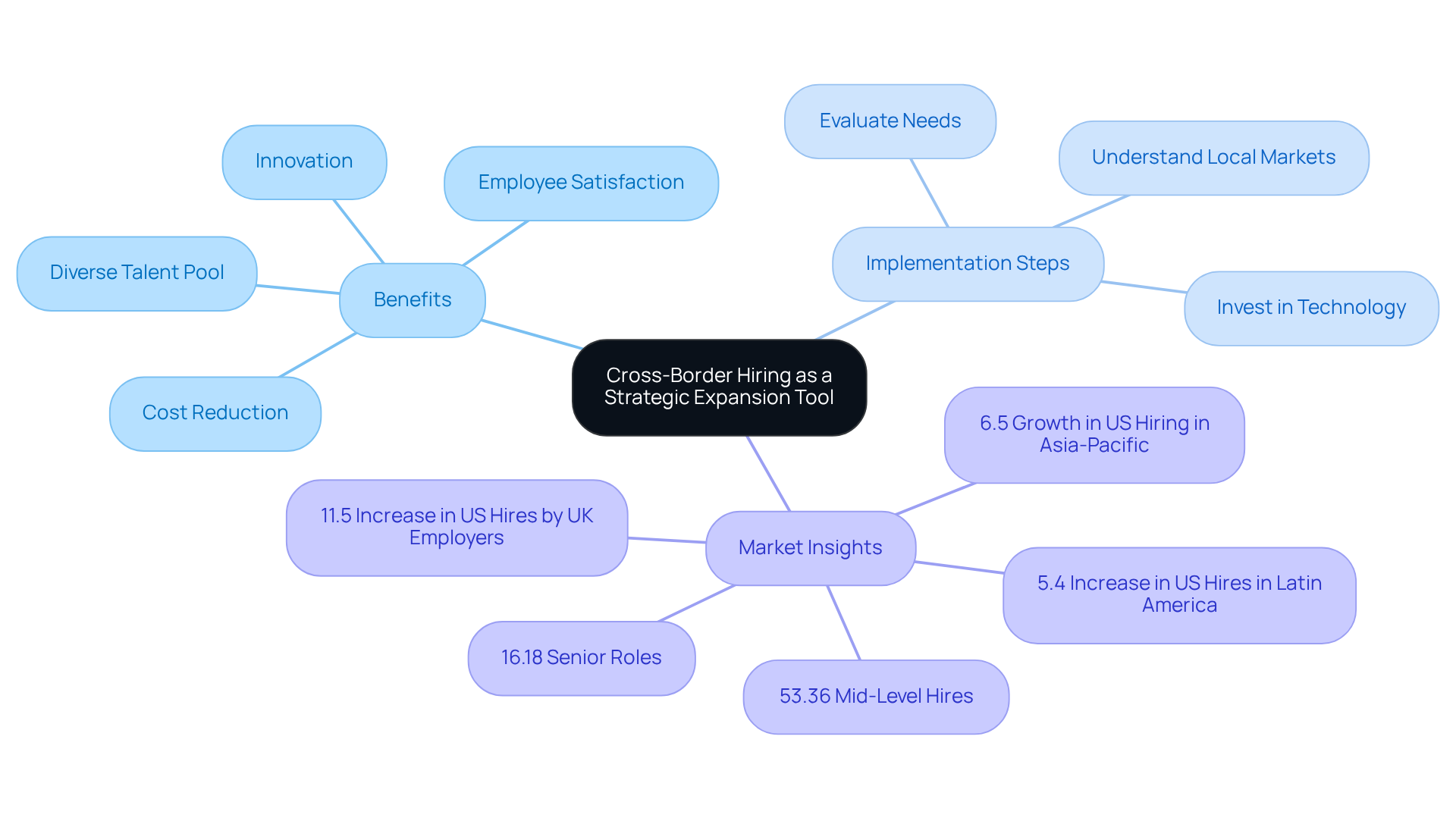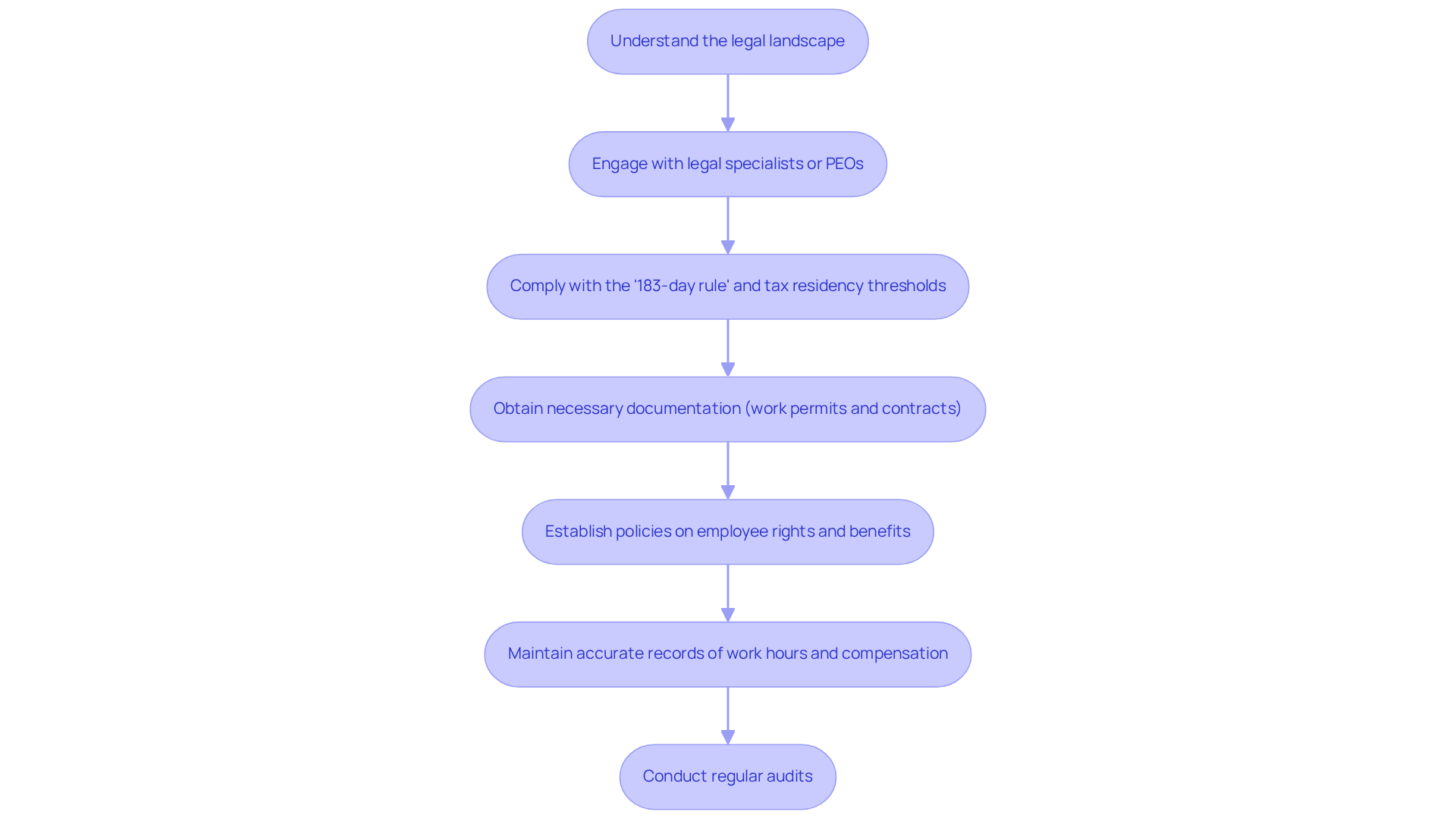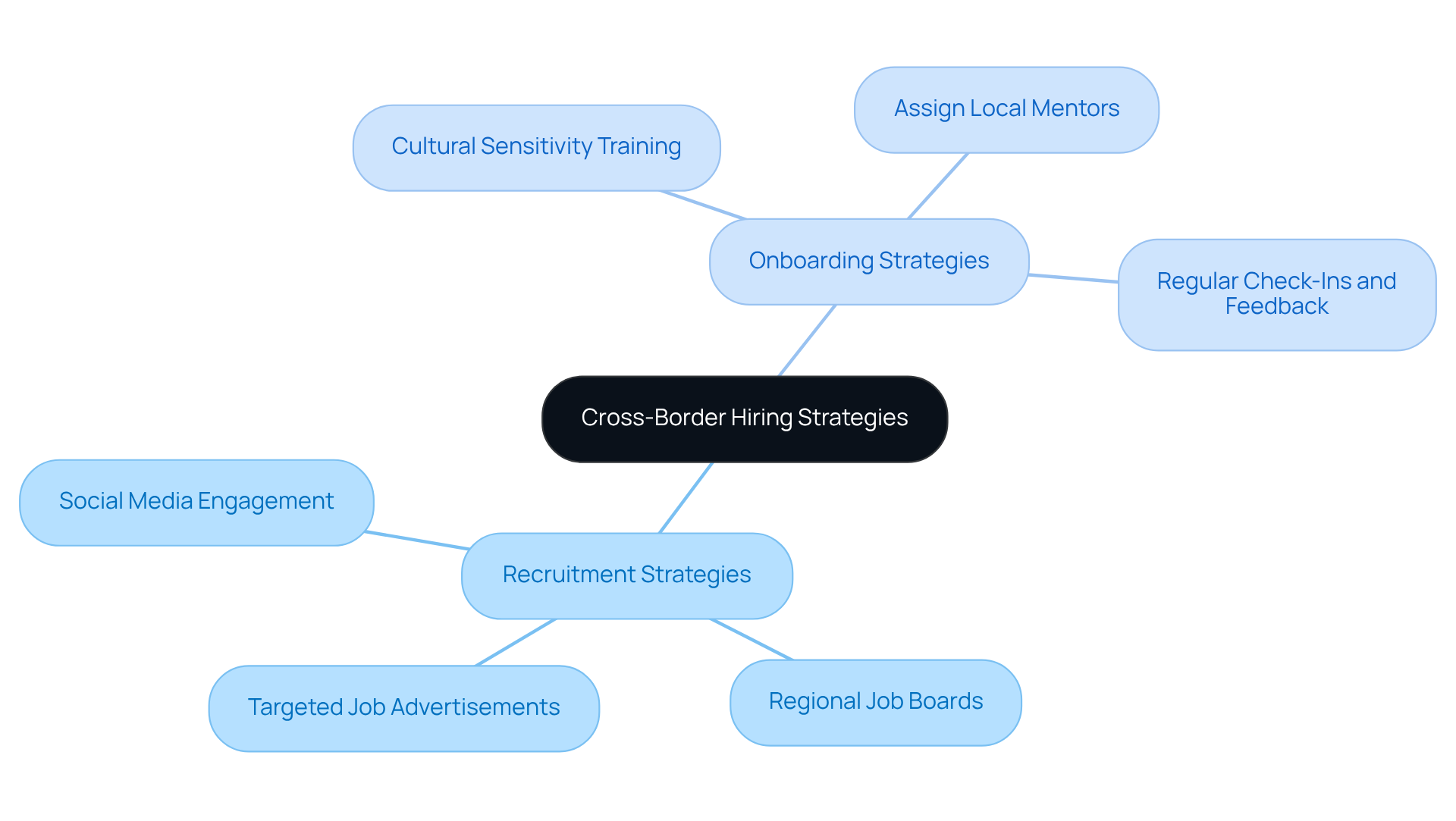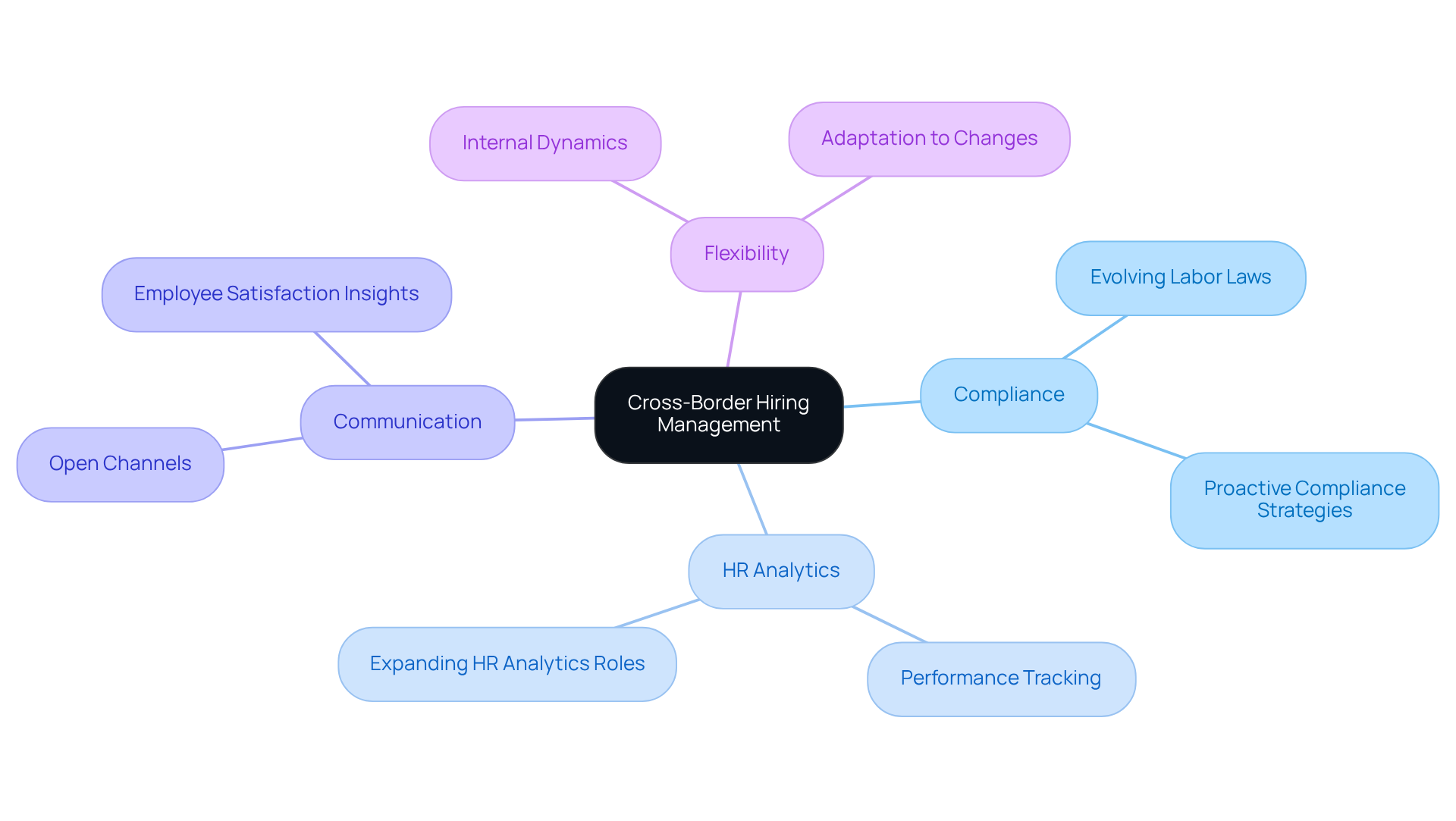Overview
Cross-border hiring signals strategic expansion, enabling organizations to tap into a diverse talent pool that enhances innovation and reduces operational costs. This approach not only addresses skill gaps but also improves employee satisfaction through diversity. Moreover, it necessitates compliance with local laws, ensuring effective integration of international hires into the workforce. By embracing global recruitment, businesses can position themselves for success in an increasingly competitive landscape.
Introduction
Cross-border hiring is swiftly emerging as a pivotal strategy for organizations seeking to enhance their competitive edge in an increasingly globalized market. By tapping into diverse talent pools, companies gain access to specialized skills that may be scarce locally, while simultaneously fostering a culture of innovation and inclusivity. However, navigating the complexities of international recruitment—from compliance with local laws to effective onboarding—presents unique challenges.
How can businesses fully harness the potential of cross-border hiring, ensuring compliance and strategic agility?
Understand Cross-Border Hiring as a Strategic Expansion Tool
Cross-border hiring empowers organizations to tap into a diverse talent pool, significantly enhancing innovation while reducing operational expenses. By recruiting globally, companies gain access to specialized skills that may be scarce in their local markets. This strategy not only broadens the company's capabilities but also nurtures a more inclusive workplace culture, fostering creativity and collaboration among team members.
To effectively leverage the advantages of , organizations must first evaluate their specific needs and identify regions that offer the desired talent. A deep understanding of local market dynamics and cultural nuances is essential for improving recruitment outcomes. For instance, organizations that embrace varied talent pools often experience heightened employee satisfaction and retention, as diverse teams are linked to greater engagement levels.
Research reveals that 53.36 percent of US hires by European employers are mid-level, with 16.18 percent in senior roles, indicating a robust demand for experienced professionals who can make immediate contributions to strategic projects. Moreover, organizations that invest in collaboration technology and effective onboarding processes are better equipped to integrate international hires, thereby enhancing overall team efficiency.
As Rick Upton from Loggerhead Fitness notes, leveraging innovative recruitment tools can significantly reduce time-to-fill and improve candidate evaluation, allowing organizations to identify high-potential individuals they might have otherwise overlooked. By viewing cross-border hiring as an expansion signal, businesses can not only address critical skill gaps but also drive innovation and sustain a competitive edge in the global market.

Prepare for Cross-Border Hiring: Compliance and Legal Essentials
Before embarking on cross-border hiring as an expansion signal, companies must thoroughly understand the legal landscape of their target countries. This involves a deep dive into , tax obligations, and immigration regulations. Engaging with regional legal specialists or a Professional Employer Organization (PEO) can provide essential insights into managing compliance challenges. Notably, numerous countries implement the '183-day rule,' where workers residing more than six months in a tax year become residents liable for regional income taxes. Some jurisdictions may apply stricter thresholds, such as 90 days, for tax residency. Consequently, possessing the correct documentation, including work permits and contracts that comply with regional laws, is essential.
Establishing clear policies regarding employee rights and benefits is crucial to mitigate potential legal disputes. Companies should maintain accurate records of employee work hours and compensation to ensure compliance with labor laws. Failing to do so can lead to significant penalties, including fines of $10,000 for each unfiled U.S. information form. Regular audits of compliance practices are vital for adapting to evolving regulations, especially in 2025, when cross-border hiring as an expansion signal becomes increasingly complex. By proactively managing these aspects, companies can not only avoid legal pitfalls but also leverage cross-border hiring as an expansion signal for successful global growth.

Execute Cross-Border Hiring: Recruitment and Onboarding Strategies
To successfully implement cross-border recruitment, organizations must develop a comprehensive strategy that includes:
- Targeted job advertisements
- The use of regional job boards
- The engagement of social media platforms
Establishing a compelling employer brand that resonates with international candidates is essential. Furthermore, during the onboarding process, it is crucial to provide:
- Cultural sensitivity training
- Assign local mentors who can assist new hires in acclimating to the company culture
Regular check-ins and feedback sessions are vital to enhancing the onboarding experience, ensuring that international employees feel valued and supported from day one.

Manage and Adapt Cross-Border Hiring: Continuous Compliance and Strategy Adjustment
Effectively managing cross-border hiring as an expansion signal requires a proactive approach to compliance and strategic adjustments. Organizations must routinely assess their recruitment practices and remain vigilant about the evolving labor laws and regulations within their operational territories.
Leveraging HR analytics is crucial for tracking the performance of international hires, allowing companies to identify areas for improvement. Notably, 34% of large organizations are expanding HR analytics roles, underscoring the growing recognition of its importance in recruitment practices.
Furthermore, fostering open communication channels with global teams can yield invaluable insights regarding the recruitment process and employee satisfaction. As Nadeem Khan aptly states, "HR will not be replaced by data analytics, but HR professionals who do not utilize data will be replaced by those who do."
By staying flexible and attentive to both internal dynamics and external regulatory changes, companies can secure the long-term success of their initiatives, viewing cross-border hiring as an expansion signal. Tools like SAP SuccessFactors can aid organizations in implementing effective HR analytics strategies. Ultimately, integrating these practices not only but also drives improved hiring outcomes.

Conclusion
Cross-border hiring stands as a crucial strategy for organizations aspiring to broaden their reach and sharpen their competitive edge. By accessing global talent pools, companies not only address critical skill shortages but also cultivate a diverse and innovative workplace culture. This strategic approach empowers businesses to utilize specialized skills that may be scarce locally, ultimately propelling growth and operational efficiency.
Key insights presented in this guide underscore the significance of grasping local market dynamics, adhering to legal requirements, and executing effective recruitment and onboarding strategies. Organizations must prioritize cultural sensitivity and ongoing adaptation to ensure the seamless integration of international hires. The focus on harnessing technology and HR analytics further demonstrates how data-driven decisions can elevate recruitment outcomes and enhance employee satisfaction.
In conclusion, embracing cross-border hiring as a signal for expansion is not merely a trend; it is a necessity for businesses striving to flourish in a global marketplace. By proactively tackling compliance challenges and consistently refining recruitment strategies, organizations can unlock the full potential of their international workforce. The journey towards successful cross-border hiring promises substantial rewards, making it essential for companies to act on these insights and position themselves for enduring success.
Frequently Asked Questions
What is cross-border hiring?
Cross-border hiring is the practice of recruiting talent from different countries, allowing organizations to access a diverse talent pool and specialized skills that may not be available in their local markets.
What are the benefits of cross-border hiring?
Cross-border hiring enhances innovation, reduces operational expenses, broadens a company's capabilities, and fosters a more inclusive workplace culture, leading to increased creativity and collaboration among team members.
How should organizations approach cross-border hiring?
Organizations should evaluate their specific needs, identify regions that offer the desired talent, and understand local market dynamics and cultural nuances to improve recruitment outcomes.
What impact does diversity have on employee satisfaction?
Diverse teams are linked to greater employee engagement, which often leads to heightened satisfaction and retention among employees.
What statistics highlight the demand for international hires?
Research indicates that 53.36 percent of US hires by European employers are mid-level positions, with 16.18 percent in senior roles, reflecting a strong demand for experienced professionals.
How can organizations effectively integrate international hires?
Organizations that invest in collaboration technology and effective onboarding processes are better equipped to integrate international hires, which enhances overall team efficiency.
What role do innovative recruitment tools play in cross-border hiring?
Innovative recruitment tools can significantly reduce time-to-fill positions and improve candidate evaluation, helping organizations identify high-potential individuals they might have otherwise overlooked.
Why should businesses view cross-border hiring as a strategic expansion tool?
By viewing cross-border hiring as an expansion signal, businesses can address critical skill gaps, drive innovation, and sustain a competitive edge in the global market.




